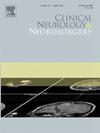神经重症监护室中患医院获得性肺炎的颅内动脉瘤破裂患者多重耐药菌感染风险预测模型的开发
IF 1.8
4区 医学
Q3 CLINICAL NEUROLOGY
引用次数: 0
摘要
目的本研究旨在探讨神经重症监护室(NICU)中患有医院获得性肺炎(HAP)的颅内动脉瘤破裂(RIA)患者的多重耐药菌(MDRO)感染率,并确定与这些感染发生相关的风险因素。方法我们收集了2018年1月至2022年12月期间328名符合条件的患者的临床和实验室数据。细菌培养结果用于评估MDRO菌株分布,并通过逻辑回归分析确定了与MDRO感染发生率相关的风险因素。这些风险因素被进一步用于建立MDRO感染发生率的预测模型,随后该模型进行了内部验证。结果在该研究队列中,26.5%的RIA HAP患者发生了MDRO感染(87/328)。这些患者中最常见的 MDRO 病原包括耐多药肺炎克雷伯菌(34.31%)和耐多药鲍曼不动杆菌(27.45%)。糖尿病(P = 0.032)、气管切开术(P = 0.004)、机械通气史(P = 0.033)、白蛋白水平较低(P < 0.001)、脑积水(P < 0.001)和格拉斯哥昏迷量表(GCS)评分≤8(P = 0.032)这六个 MDRO 危险因素均与 MDRO 感染率独立相关。该预测模型表现出令人满意的区分度(曲线下面积 [AUC],0.842)和校准度(斜率,1.000),决策曲线分析进一步支持了该模型的临床实用性。所开发的预测模型可帮助临床医生识别和筛查高危患者,预防 MDRO 感染。本文章由计算机程序翻译,如有差异,请以英文原文为准。
Development of a model to predict the risk of multi-drug resistant organism infections in ruptured intracranial aneurysms patients with hospital-acquired pneumonia in the neurological intensive care unit
Objective
This study was developed to explore the incidence of multi-drug resistant organism (MDRO) infections among ruptured intracranial aneurysms(RIA) patient with hospital-acquired pneumonia(HAP) in the neurological intensive care unit (NICU), and to establish risk factors related to the development of these infections.
Methods
We collected clinical and laboratory data from 328 eligible patients from January 2018 to December 2022. Bacterial culture results were used to assess MDRO strain distributions, and risk factors related to MDRO infection incidence were identified through logistic regression analyses. These risk factors were further used to establish a predictive model for the incidence of MDRO infections, after which this model underwent internal validation.
Results
In this study cohort, 26.5 % of RIA patients with HAP developed MDRO infections (87/328). The most common MDRO pathogens in these patients included Multidrug-resistant Klebsiella pneumoniae (34.31 %) and Multidrug-resistant Acinetobacter baumannii (27.45 %). Six MDRO risk factors, namely, diabetes (P = 0.032), tracheotomy (P = 0.004), history of mechanical ventilation (P = 0.033), lower albumin levels (P < 0.001), hydrocephalus (P < 0.001) and Glasgow Coma Scale (GCS) score ≤8 (P = 0.032) were all independently correlated with MDRO infection incidence. The prediction model exhibited satisfactory discrimination (area under the curve [AUC], 0.842) and calibration (slope, 1.000), with a decision curve analysis further supporting the clinical utility of this model.
Conclusions
In summary, risk factors and bacterial distributions associated with MDRO infections among RIA patients with HAP in the NICU were herein assessed. The developed predictive model can aid clinicians to identify and screen high-risk patients for preventing MDRO infections.
求助全文
通过发布文献求助,成功后即可免费获取论文全文。
去求助
来源期刊

Clinical Neurology and Neurosurgery
医学-临床神经学
CiteScore
3.70
自引率
5.30%
发文量
358
审稿时长
46 days
期刊介绍:
Clinical Neurology and Neurosurgery is devoted to publishing papers and reports on the clinical aspects of neurology and neurosurgery. It is an international forum for papers of high scientific standard that are of interest to Neurologists and Neurosurgeons world-wide.
 求助内容:
求助内容: 应助结果提醒方式:
应助结果提醒方式:


